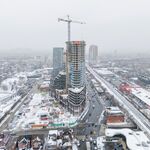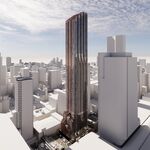steveintoronto
Superstar
More re: ^
I find this increasingly the case in Toronto:
[“So it’s not only cars that are a dangerous element. It can be the cyclists alongside each other,” Chaloux said. “What often comes up in surveys is that a lot of people are scared of their fellow cyclists.”]
http://montrealgazette.com/news/loc...st-by-montreal-cyclists-located-on-bike-pathsIntersections feared most by Montreal cyclists located on bike paths
"This suggests that the designs we are currently using to facilitate cycling in the city are not working to reduce safety fears"
RENÉ BRUEMMER, MONTREAL GAZETTE
Updated: June 23, 2018
The intersections considered by cyclists to be the most dangerous in Montreal are located on some of its most popular bike paths, which were meant to alleviate fears, a new survey suggests.
Included among the worst are the corner where the de Maisonneuve bike path intersects with Berri St., the confluence of Park and Pine Aves., and most of the intersections located along the Rachel St. bike path, one of the busiest in the city.
“It is notable that the most dangerous intersections identified by current cyclists closely follow existing cycling infrastructure — especially the de Maisonneuve and Rachel bike paths,” said head researcher Nick Chaloux, a masters student at McGill University’s school of urban planning. “This suggests that the designs we are currently using to facilitate cycling in the city are not working to reduce safety fears.”
Normally, intersections with bike-path lanes that are heavily used tend to be safer, Chaloux said, because the masses of people using them create more visibility and awareness on the part of users and drivers, a concept referred to as safety in numbers. Instead, at some of the city’s busiest bike intersections, the opposite effect is occurring.
In between intersections on those bike paths, cyclists typically feel very safe, exacerbating the problem, Chaloux noted.
“It’s when you hit the intersection itself that the false sense of safety comes into play, because all of a sudden you have no protection from cars, you have a lane of traffic that you’re not expecting to be there with the bike lane, the traffic lane and the pedestrian lane, and if you’re trying to turn, cars are also trying to turn, it just doesn’t work.
“The reality is that we put a lot of money into the in-between infrastructure, but we never put in bike boxes or signals or anything else at the intersections themselves,” he said.
Poorly designed bike-path intersections result in a convergence of drivers, pedestrians and cyclists who don’t know how to respond to the unregulated space.
“That’s why a lot of accidents are happening around these intersections,” Chaloux said. “People are getting hurt. People are dying. It’s inexcusable that we’re not finding ways to stop it.”
The new data came to light as part of a research project started by McGill’s Transportation Research At McGill (TRAM) group, a division of the university’s school of urban planning that does research primarily linked to transportation.
Nearly 1,400 respondents, most of them daily commuters, filled out surveys online in the spring about their biking habits and their perceptions of danger. The idea was to gauge how to plan cycling infrastructure for different levels of cyclists — the overconfident, those hesitant to try urban cycling, and those in between. A lack of infrastructure that makes cyclists feel safe is one of the main impediments to coercing more people to take up bike commuting.
Montreal’s bike infrastructure, such as its two-way bike lanes on de Maisonneuve and Rachel, were effective at getting people to start commuting, Chaloux said. But now they have become a victim of their own success, attracting many levels of cyclists, some whom meander slowly, while others pass at high speeds.
“So it’s not only cars that are a dangerous element. It can be the cyclists alongside each other,” Chaloux said. “What often comes up in surveys is that a lot of people are scared of their fellow cyclists.”
Dedicated turn signals that give cyclists and cars the opportunity to proceed without fear of collision are one simple solution that Montreal should institute widely but has not, Chaloux said. Lowering vehicular speed limits is another solution.
The fact the city’s new plans for bike paths are often of the safer, uni-directional model, and separated from car traffic, is a sign of hope. Another is the fact the administration is starting to consult active cyclists on what kind of infrastructure they would prefer to see and where they think it should be placed for maximum efficiency.
“They’re reaching out to the cycling community,” Chaloux said. “I think that’s crucial in any city.”
Full details of the TRAM study are expected by the end of July.
rbruemmer@postmedia.com
twitter.com/renebruemmer
I find this increasingly the case in Toronto:
[“So it’s not only cars that are a dangerous element. It can be the cyclists alongside each other,” Chaloux said. “What often comes up in surveys is that a lot of people are scared of their fellow cyclists.”]









/https://www.thestar.com/content/dam/thestar/opinion/star-columnists/2018/06/27/good-design-makes-tricky-intersection-easy-to-navigate-for-drivers-and-cyclists/bikes_and_cars_at_interesection.jpg)


